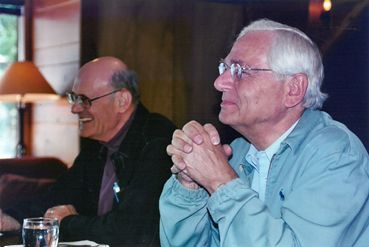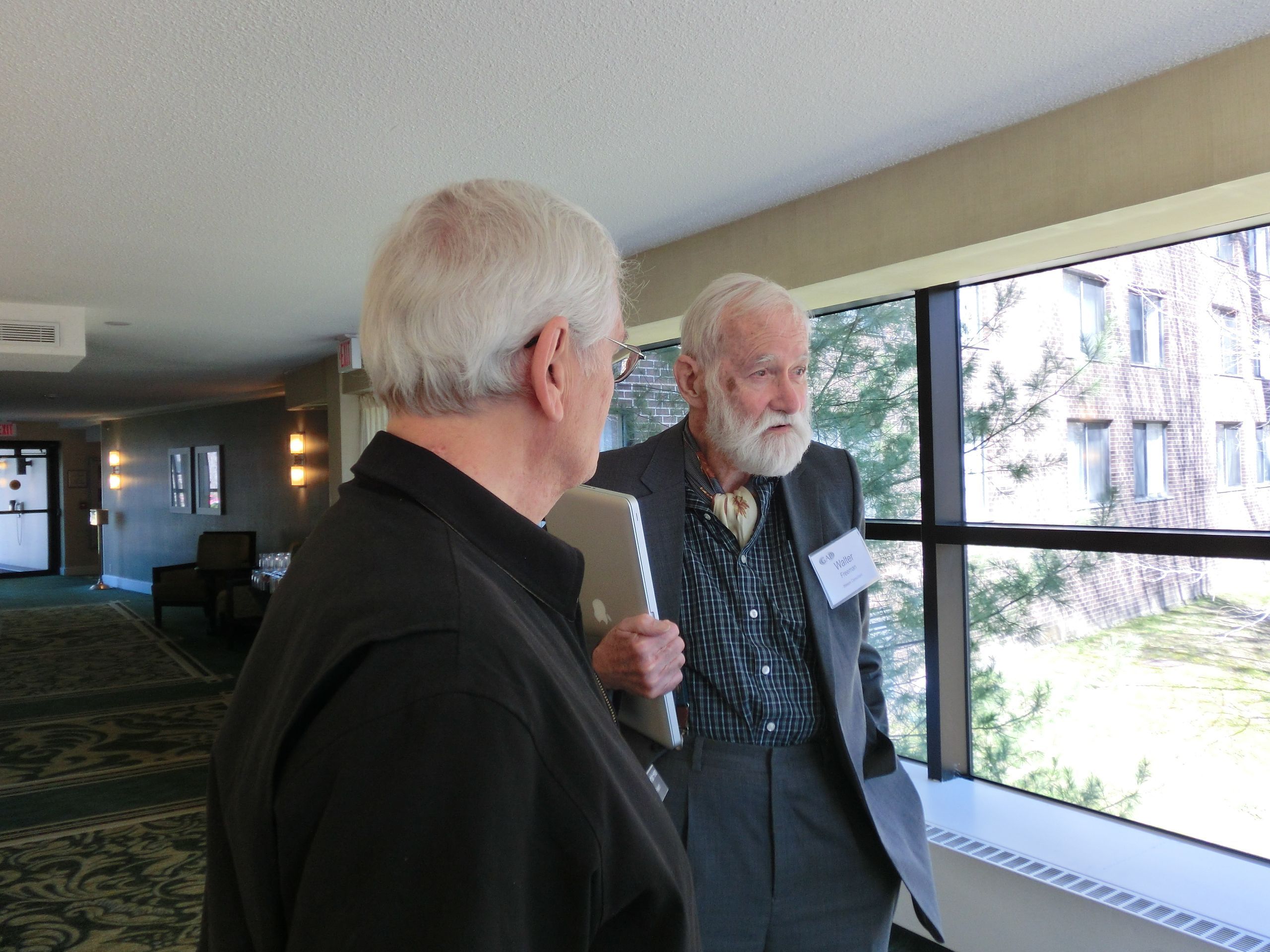Article
Remembering: A Gentleman and a Psychiatrist
Author(s):
Johan Verhulst, MD, left this world exactly as he lived-with grace, honor, integrity, humor, love, humility, intellect, and a continuing interest in our ongoing professional conversations.
Dr Verhulst with Dr Cornelius (Cor) Bakker

Dr Freeman and Dr Verhulst, GAP Research Committee meeting, Spring 2012

IN MEMORIAM
Johan Verhulst, MD (1938 – 2019)
Johan left this world exactly as he lived, with grace, honor, integrity, humor, love, humility, intellect, and a continuing interest in our ongoing professional conversations. Dr Verhulst was a member of the Group for the Advancement of Psychiatry from 1999 to 2019.
An incredible departure
In the last months of Johan’s beautiful life, he engaged Ronald Pies, MD, Editor in Chief Emeritus of Psychiatric Times, in a published discussion on dignity and autonomy at the end of life, physician assisted suicide, and the role of physicians with respect to the “self determination of another person.” 1 Dr Verhulst concludes, “The autonomy-limiting effect of the medical control is a reality, which cannot be negated by ethical intentions or by the unshakable, yet totally unsubstantiated belief that-in the absence of manifest pathology-physicians are capable of distinguishing between a healthy and an unhealthy desire to control the end of one’s life.”2
Johan also co-authored a final publication, with contributions from his wife, Dr Julia Heiman, a thoughtful article on undecidable human dilemmas, published posthumously online in Psychiatric Times.3 Co-authored by fellow GAP Research Committee member, John Beahrs, MD, they begin, “The parties to such dilemmas often share a common ambivalence about the issue but gravitate to opposite poles; then they come into conflict and become increasingly polarized-at each other’s throats over what they actually share.” The authors conclude, “In all such cases, the parties had possessed common interest with shared ambivalence, selectively swung to opposite poles through binary thinking, and came into unnecessary but increasingly intractable conflict. Perhaps validating the nature of undecidable choices and shared ambivalence can offer more hope for human reconciliation.”
An incredible life
Johan had an incredible life and an equally incredible career. He was born in Leuven, Belgium, in 1938. Medical school and a master’s in psychology were at Katholieke Universiteit. Residency in psychiatry began at the University of Leuven and was completed at the University of Utrecht in Holland. Psychoanalytic training with training analysis was at the Amsterdam Psychoanalytic Institute, and training in group psychotherapy was with the Dutch Society for Group and Family Therapy. His training analysis was with S. J. R. de Monchy, MD,4,5 who in turn had been analyzed by Freud (twice).6
Johan was a visiting professor at the University of Washington in Seattle, both in 1971 and 1977. Following the second visiting professorship, he remained there for the duration of his career. He was a beloved and highly recognized Training Director at the University of Washington for 12 years, receiving the Faculty Teaching Award three times (1986, 1992, and 1996), and the Gary Tucker Career Education Award in 2006. Dr Tucker was a mentor, colleague, and friend. They collaborated on two articles, “Medical and narrative approaches in psychiatry,”7 and later, “How many psychiatrists do we need?”8 The photo is with his friend, colleague in the residency training program, and former GAP Research Committee member, Dr Cornelius (Cor) Bakker.12
At the GAP Research Committee meeting two years ago, I mentioned the “best psychiatrist in Madison (WI).” With a twinkle in his eye, Johan asked, “Who might that be?” The answer: Art Walaszek, coincidentally the Training Director for 15 years (and continuing) at the University of Wisconsin. Johan responded-proudly but understated, “Dr Walaszek trained with us.” I should have known.
Dr Verhulst’s first publication, “Compensation neurosis and pseudo-identity,”9 was published in the Belgium Journal of Medicine. The first of nine publications with his spouse, Dr Julia Heiman, Director of The Kinsey Institute (2014), “An interactional approach to sexual dysfunctions,” was published in 1979 in the American Journal of Family Therapy.10 Their final joint publication was in 2003, “Childhood sexuality and adult sexual relationships: How are they connected by data and by theory?”11
The social brain: A unifying foundation for psychiatry
Perhaps the culmination of Dr Verhulst’s intellectual career has been the “social brain” concept with relevance to psychiatry. Dr Verhulst was the leader of the GAP Research Committee project on the social brain that resulted in multiple publications. An initial brief description, “The social brain: A unifying foundation for psychiatry,” was published as a letter to Academic Psychiatry in 2002.12 A full article, “The social brain in clinical practice,” followed in 2005.13[PDF] In the latter, the authors proposed, “that seeing psychiatry’s core organ as the ‘social brain’ refines and extends the basic science of psychiatry.” In the “unifying foundation” article, the authors assert:
The social brain is defined by its function-namely, the brain is a body organ that mediates social interactions while also serving as the repository of those interactions. The concept focuses on the interface between brain physiology and the individual’s environment . . . Brains, including human brains, derive from ancient adaptations to diverse environments and are themselves repositories of phylogenetic adaptations. In addition, individual experiences shape the brain through epigenesis; that is, the expression of genes is shaped by environmental influences. Thus, the social brain is also a repository of individual development . . . The social brain concept allows psychiatry to utilize pathogenesis in a manner parallel to practice in other specialties.
These two GAP Research Committee articles introduced the term “social brain” to the psychiatric/medical/psychological literature. The only prior reference to the “social brain” was (appropriately) in the anthropology literature where the idea was described by Robin I. M. Dunbar, a British anthropologist and evolutionary psychologist, in 1998.14 Although not using the term “social brain,” nor focusing on the relevance to psychiatry, the most pre-eminent neuroscientist of the 20th century, in my opinion, and Johan’s, Walter J. Freeman, MD, proposed a similar idea in his book, Societies of Brains: “The most important function of brains is to interact with each other to form families and societies . . . meaning arises in social relations (page 1).”15 The accompanying photograph shows Dr Freeman and Dr Verhulst talking during a break at the GAP Research Committee meeting – Spring 2012.
Thus, all subsequent reference to the social brain concept in the psychiatric literature derives from the work of Johan Verhulst and colleagues of the GAP Research Committee. For example, “An organ system for a social organ must, by definition, include other social organs (ie, other brains). One brain cannot evolve in isolation from other brains. Social organs, by necessity, interact just as fluidly as the liver and pancreas or the heart and lungs. The science of the last 25 years is consistent with the philosophies of Ackerman, Bateson, and Whitaker. The Primate Social Organ System (PSOS) is thus the organ system of interest to psychiatrists.”16
Eight days before Johan departed, he sent colleagues a two page “theoretical framework” because he believed an update on the social brain concept was needed. I want to emphasize eight days, and my prior mention of the incredible intellect possessed by our friend. Here is the first paragraph (copies available upon request):
The social brain consists of structures and processes in the nervous system that incorporate embodied interactional knowledge, which is the result of social learning at different levels. Thus, the social brain includes: (a) the effects of evolutionary learning exemplified in the genetically encoded adaptations to living in social groups, subject to epigenetic changes, (b) the effects of basic developmental learning in early childhood through engagement in specific interaction patterns that help form a first sense of self, others, and interpersonal context, and (c) the effects of socio-cultural learning through on-going discourse in the family, society, and the broader culture; through these interactions one acquires schemas of one’s social role and that of others in various contexts; these schemas further develop one’s sense of self and may be modified with new interpersonal experiences.
Preparing friends for his exit
Johan was particularly proud of an award he received in 1978, the Kruis van Ridder in de Kroonorde (Cross of Knight in the Order of the Crown), awarded by the King of Belgium-perhaps a form of knighthood in Belgium. The award was for his public service (including his military service). His father was awarded the same designation before him. About a year ago, he told me that among other benefits the award provides for is a detachment of the Belgium Army to fire rifles over his gravesite-near his cabin on the Puget Sound.
Two years ago, a small group of colleagues including Johan began sharing jokes and humorous stories, sometimes called “Jumor for Johan.” Johan was an active contributor and had some of the very best stories, and he appreciated the intent. This sharing of humor closed on May 3, 2019. Sometime prior to that day, he told us, “I have enjoyed, and am grateful for, the respect and warmth that always infused our interesting conversations. And I am sorry but I plan on taking the best jokes with me into eternity. With friendship and may you survive me in health and happiness, Johan.” And Johan did have some of the best! Here is his final contribution to Jumor for Johan in reply to a mutual friend’s dream on dying that was followed by a joke comparing Heaven and Hell:
Hello my dreaming friend, walking in the clouds as a result of the unbelievably wonderful and touching emails from my friends of the Research Committee, I had decided not answer any of them. After all, keeping an email exchange going carries the risk of getting "on the other hand" messages. However, I cannot do so in your case. I have to respond. To start with, the joke at the end of your email was quite hurtful (it hurts when I laugh!!). Nevertheless, I will secretly pass it on to Mr Peter (that's how he now prefers to be called) at the gates. On the other hand, really disturbing is your email's revelation that the afterlife is just like it is in the here and now. So the bureaucrats have won and conquered the hereafter!!?? I still know that, in reality, my upcoming exit is a well-deserved, personal triumph over the curse of immortality, but now you make me realize that it is but a pyrrhic victory! Thanks a lot, friend! I "cc" Doug, the chair of our committee, as a disciplinary action may be warranted. With deep despair, triggered by the spectre of an eternity of looming electronic medical records, Johan.
Our relationship in this life did not end with bureaucrats, pyrrhic victories, and disciplinary action, which did serve to lessen our sense of an impending loss, but with warm, honest, loving final expressions the following day. My thanks to Dr Julia Heiman and Dr David Keith for significant contributions to this remembrance.
Of the wise men I have known, you’ve been the wisest and the warmest
I will close with what I believed at the time would be my final email to Johan (April 29, 2019), but he insisted on continuing the conversation (as you have seen above), with a few friends, our back-and-forth interweaving of love and humor until May 3rd, six days before his departure.
“Dear Johan, Of the wise men I have known, you’ve been the wisest and the warmest. I know there was a cost, but thank you for hanging out a bit longer than you anticipated. In life and in death, you've had both dignity and integrity. You run circles around most with your intellect, but your humility prevents the awareness. You are a gentle man for the ages. The jokes have been and will be a continuing connection. (On a professional note, your Medical Alliance16 paper will be a beacon for future physicians when the shaman is resurrected.) With enduring friendship, and with my love, may peace be with you always. Doug.”
Goodbye my friend . . .
Douglas A. Kramer, MD, MS
Middleton, WI
Chair, Committee on Research
Group for the Advancement of Psychiatry
Editor's note: This piece was originally published in the Group for the Advancement of Psychiatry Newsletter. It is published here with permission.
References:
1. Geppert C, Pies R. Two misleading myths regarding “medical aid in dying.”Psychiatric Times. 2018;35(8).
2. Verhulst J. Letter to the editor by Johan Verhulst, MD, FACP. Psychiatric Times. August 30, 2018. https://www.psychiatrictimes.com/two-misleading-myths-regarding-medical-aid-dying/page/0/4.
3. Verhulst J, Beahrs J. Undecidable choices and the polarization of shared ambivalence: What can psychiatry add to dispute resolution? Psychiatric Times. September 20, 2019. https://www.psychiatrictimes.com/couch-crisis/undecidable-choices-and-polarization-shared-ambivalence-what-can-psychiatry-add-dispute-resolution.
4. de Monchy SJR. Rhythmical convergence spasm of the eyes in a case of tumour of the pineal gland. Brain. 1923;46:179-188.
5. de Monchy SJR. Adam - Cain - Oedipus. American Imago. 1962;19:3-17.
6. Székely L. Obituary –– S. J. R. de Monchy, 1893-1969. Int J Psychoanal. 1971;52: 201-202.
7. Verhulst J, Tucker G. Medical and narrative approaches in psychiatry. Psychiatr Serv. 1995;46:513-514.
8. Verhulst J, Tucker G. How many psychiatrists do we need? Acad Psychiatry. 1995;19:219-223.
9. Verhulst J. Renteneurose en pseudo-identiteit. Belgian Journal of Medicine. 1970;70:500-504.
10. Verhulst J, Heiman J. An interactional approach to sexual dysfunctions. American Journal of Family Therapy. 1979;7:19-36.
11. Heiman J, Verhulst J, Heard-Davidson A. Childhood sexuality and adult sexual relationships: How are they connected by data and by theory? In: Bancroft J, Ed. Sexual Development in Childhood. Bloomington, IN: Indiana University Press; 2003.
12. Bakker C, Gardner R, Jr, Koliatsos V, et al. The social brain: A unifying foundation for psychiatry. Acad Psychiatry. 2002;26:219.
13. Verhulst J, Gardner R, Sutton B, Beahrs J, et al. The social brain in clinical practice. Psychiatr Annals. 2005;35:803-811.
14. Dunbar R. The social brain hypothesis. Evol Anthropol. 1998;6:178-190.
15. Kramer DA. History of family psychiatry: from the social reform era to the Primate Social Organ System. Child Adolesc Psychiatr Clin N Am. 2015;24:439-455. https://www.childpsych.theclinics.com/article/S1056-4993(15)00013-9/fulltext.
16. Verhulst J, Kramer D, Swann AC, et al. The medical alliance: from placebo response to alliance effect. J Nerv Ment Dis. 2013;201:546-552.






